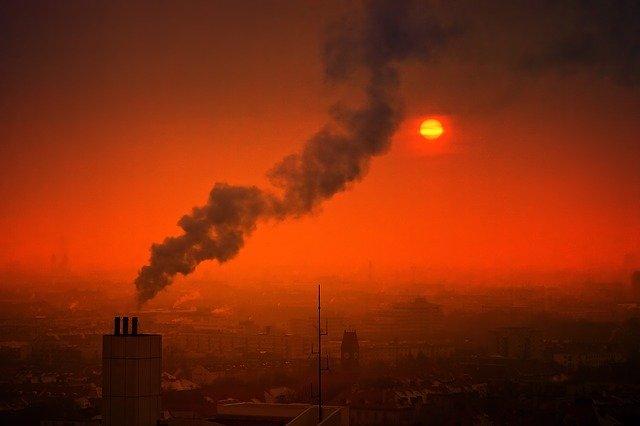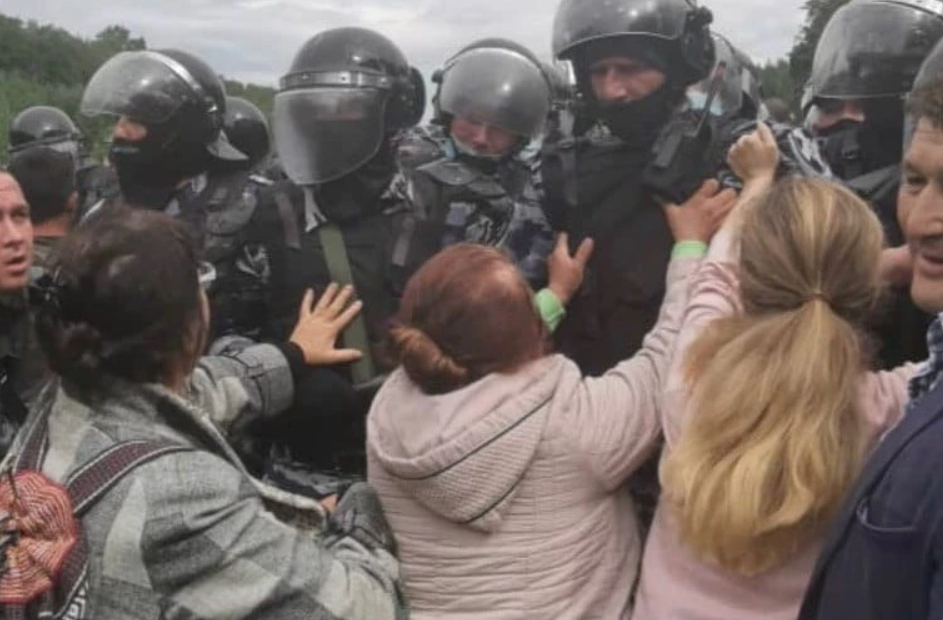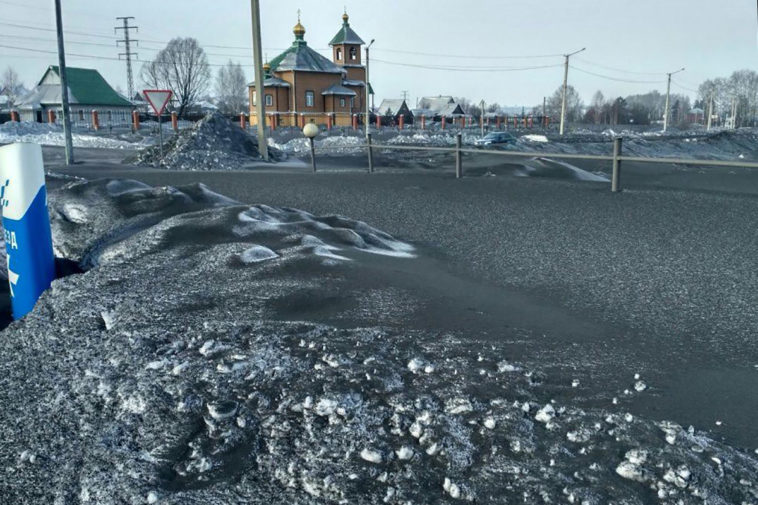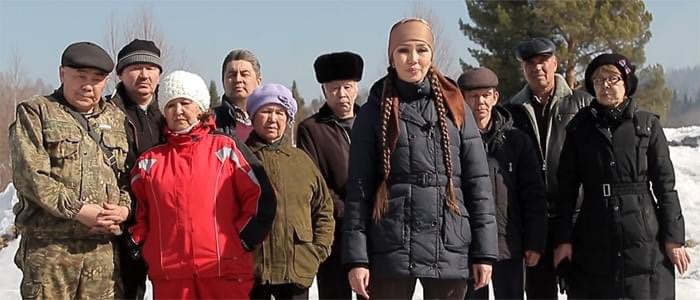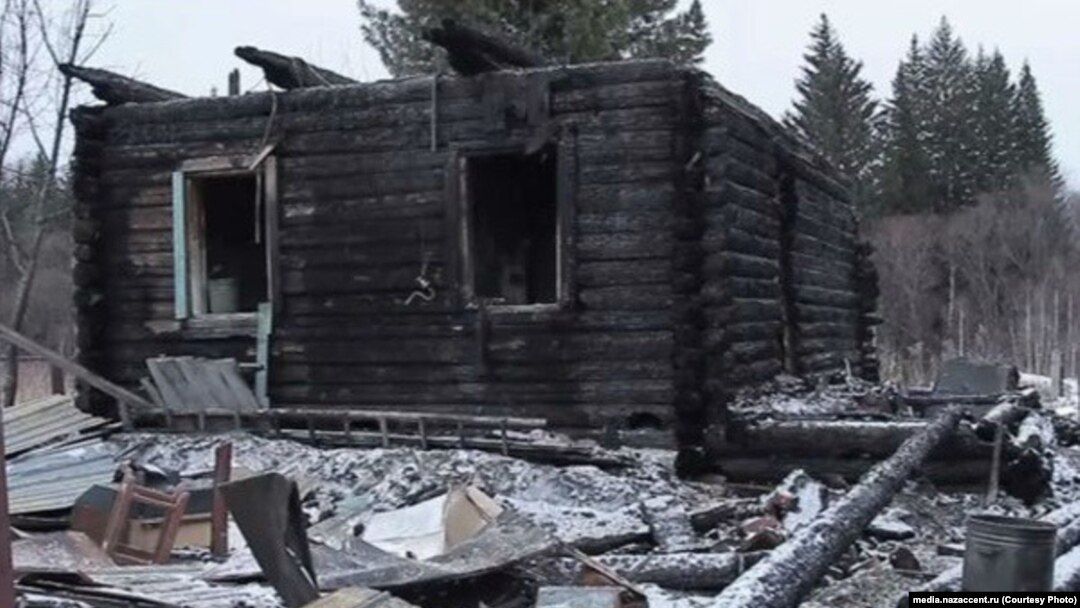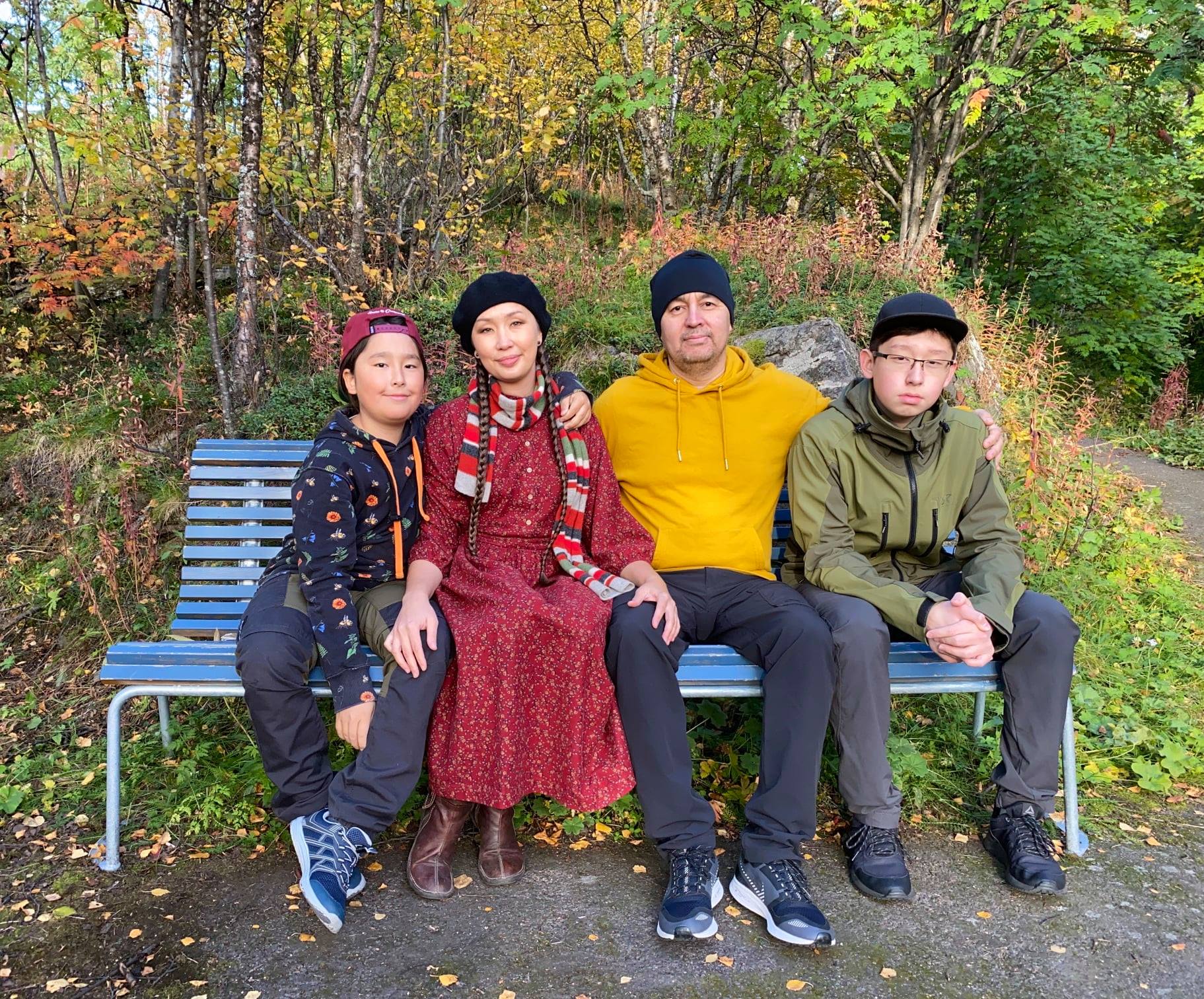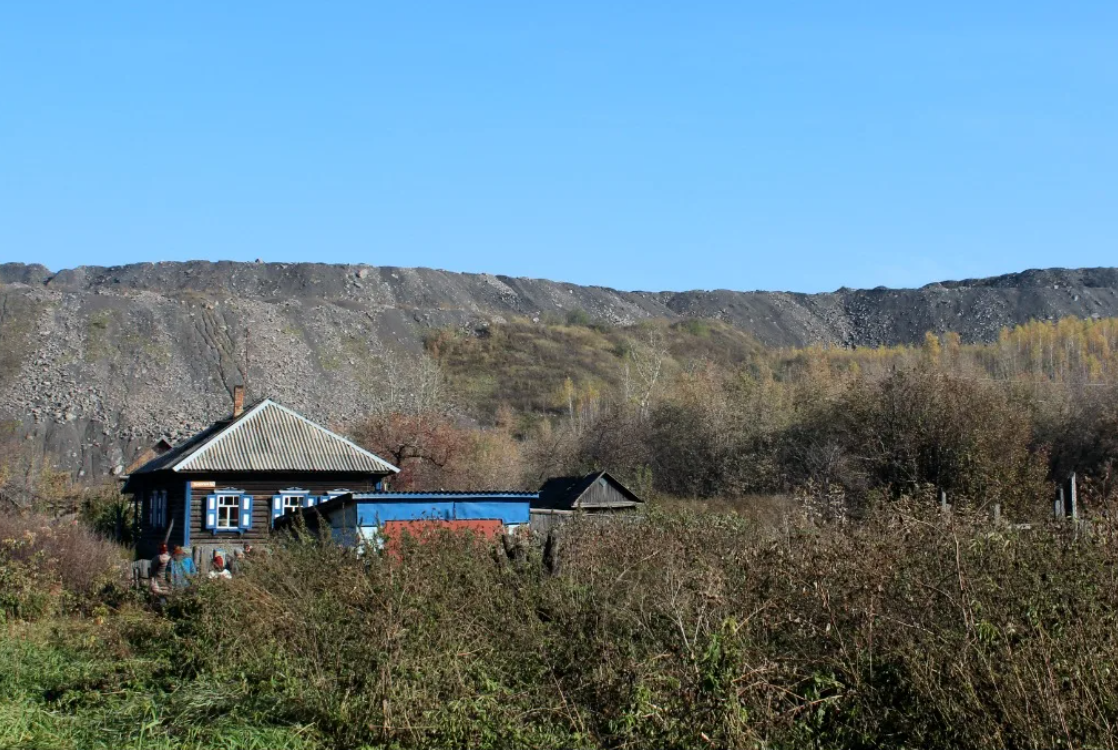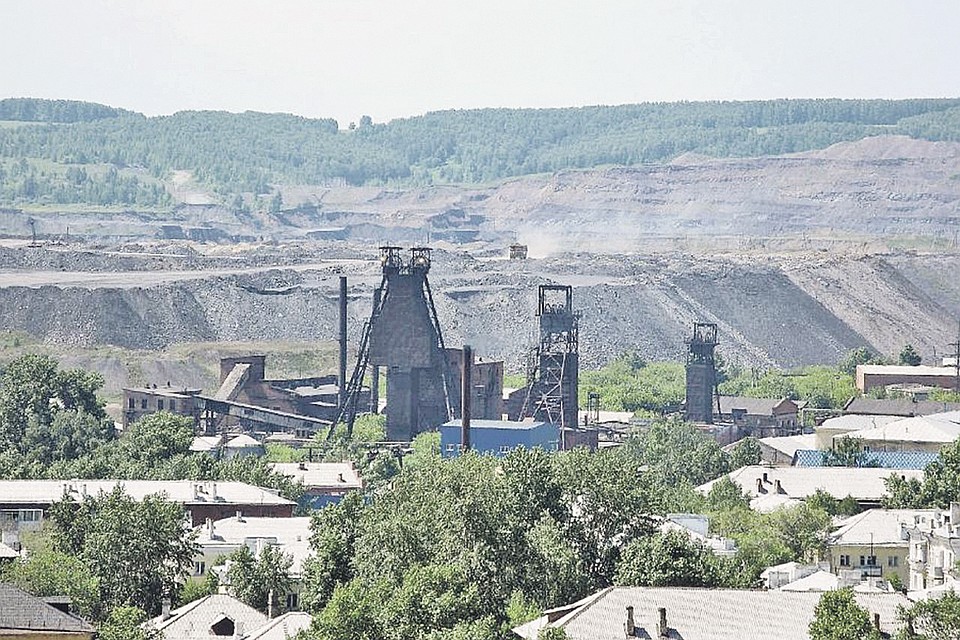Russia today is characterized by a series of arrests, searches, mistrials and other repressive actions against political opponents of the government. Politicians, journalists, and public figures have to face the repressive machine quite often. Even ordinary citizens who are far from politics but due to circumstances found themselves in the center of political events are under pressure. They can be fired from their jobs, their relatives and neighbors are being intimidated, they are often convicted under false criminal and administrative charges. Russia nowadays looks appalling from the outside because of systematic violations of the UN Convention on Human Rights.
However, only few people realize the real scale of human rights violations in Russia. There are violations of the fundamental right - the right to life. Along with frequent arrests, trials, falsified criminal cases, job dismissals, along with all these repressive measures in the Russian Federation, there are violations of the human right to a safe environment and the right to know about the ecological situation.
In March 2021, a significant event took place: at the Presidium of the Siberian Branch of the Russian Academy of Sciences (SB RAS) session it was announced that 78% of approximately twenty Russian cities with high and very high levels of air pollution are located in the Siberian Federal District. However, the session participants decided to classify the report (which had been prepared on the information from open sources) so that it would not be considered a “bomb before the elections”.
The session of the Presidium that was dedicated to ecology took place in Novosibirsk on March 25. The record of the event was posted on Youtube but was deleted later. Still, it remained at the disposal of “Tayga.info” media.
Police detain activists in Kushtau
Igor Ptashnik, the Director of the Institute of Atmospheric Optics of SB RAS, presented a report about the state of cities in the Siberian Federal District.
According to his speech, 78% of twenty Russian cities with high and very high levels of air pollution are located in the Siberian Federal District (SFD). The integral index of air pollution in 23 Siberian cities is evaluated as a high one.
Almost the entire population (99%) of the Taymyr Autonomous Okrug, where Norilsk is located, lives with extremely high air pollution.
Scientists have analyzed not just the level of pollution in Siberia but also the diseases of the Siberia inhabitants. According to their data, the cities with the highest morbidity rate are Kemerovo, Krasnoyarsk, Novokuznetsk, and Irkutsk. There are many cases of oncopathology in the Krasnoyarsk Krai; there are congenital malformations in Kemerovo Oblast; there are diseases of children in Altai Krai.
After the presentation, participants briefly discussed the issue and concluded that it was not worth publishing the report, despite the fact that it was based on open data and had already been announced live on the SB RAS channel. At the same time, similar reports of Roshydromet and the Ministry of Natural Resources of the Russian Federation were published in the media quite often in recent years. Also, the scientist said that air and water quality measurements were carried out by Roshydromet specialists.
In Kuzbass, children make snowmen from black snow
‘There is no need to be alarmists,’ said the chairman of the SB RAS, the academic Valentin Parmon. ‘Roshydromet often does not have accurate enough instruments; they may have wrong results.’
What does it mean for Russians who live in the Siberian Federal District? This means that the residents of the Siberian Federal District receive official data about the environment which are criticized by the scientists themselves. This critique is so serious that the chairman of the SB RAS, the academician Valentin Parmon, expressed his distrust at the session of the Presidium. Moreover, even these criticized data were so depressing that the academics decided to hide the report from the public.
The territory of the Siberian Federal District amounts to 25.47% of the Russian territory, its population as of January 1, 2021, is 17,009.2 thousand people. That means that 17 million people live in environmentally alarming conditions which scientists do not dare to voice on the eve of the elections. But the report has already hit the information network:
Characteristics of cities with a high level of air pollution
|
|
TLV multiplicity of |
Emissions |
Emissions rank per |
|
|
|
benzopyrene |
|
capita |
high level of pollution in 14 where the |
||
|
|
|
|
priority pollutant is benzopyrene the |
||
|
|
|
|
|
||
|
Norilsk |
1790,4 |
1 |
frequency of exceeding TLV is 116 times more in 2017-2019 |
||
|
|
|
|
|
||
|
|
|
|
|
||
|
Novokuznetsk |
37,6 |
290,8 |
4 |
amount of emission of 1,790.4 thousand tons per year prior pollutants are SO2 (9,6 |
|
|
TLV) and H2S (9,4 TLV) |
|||||
|
|
|
|
|
||
|
Krasnoyarsk |
30,6 |
186,2 |
8 |
population are the leaders among the cities |
|
|
with the biggest amount of emissions. |
|||||
|
|
|
|
|
||
|
Bratsk |
50,2 |
127,4 |
3 |
|
|
|
|
|
|
|
||
|
Chita |
well: Shelekhov – 2nd rank; |
||||
|
|
Usoliye-Sibirskoye – 5th rank; |
||||
|
Irkutsk |
13,9 |
117,3 |
7 |
||
|
Lesosibirsk – 6th rank. |
|||||
|
Barnaul |
52,2 |
87,3 |
10 |
* Here and further 1st rank means the |
|
|
|
|
|
|
worst situation. |
|
|
Usoliye-Sibirskoye |
49,4 |
24,9 |
5 |
||
|
Shelekhov |
44,2 |
36,9 |
2 |
|
|
|
Lesosibirsk |
24,4 |
15,3 |
6 |
|
|
|
Abakan |
88,2 |
13,5 |
13 |
|
|
|
Kyzyl |
116 |
11,4 |
13 |
|
|
|
Chernogorsk |
40,2 |
10,5 |
11 |
|
|
|
Cheremkhovo |
33,5 |
7 |
9 |
|
|
|
Minusinsk |
89,9 |
1,5 |
15 |
|
|
|
Svirsk |
62,7 |
1,4 |
12 |
|
|
|
Zima |
111 |
1,1 |
14 |
|
Characteristics of air pollution in Siberian Federal District
Air pollution dynamics in 2017–2019 and the indicators of API in 2019 in the cities which are the part of the program ‘Pure air’
|
City |
Region of Russia |
API* |
Pollutants |
|||||
|
Year |
Indicators of API** |
Measured at fxed observation points*** |
||||||
|
2017 |
2018 |
2019 |
Complex API5 |
SI>=10 |
NP>=20 |
|||
|
Bratsk |
Irkutsk Oblast |
VH |
VH |
VH |
|
|
|
|
|
Krasnoyarsk |
Krasnoyarsk Krai |
VH |
VH |
H |
|
|
|
|
|
Novokuznetsk |
Kemerovo Oblast |
VH |
VH |
VH |
|
|
|
|
|
Norilsk**** |
Taymyr Autonomous District (part of Krasnoyarsk Krai) |
VH |
VH |
VH |
|
|
|
|
|
Chita |
Zabaikalskiy Krai |
VH |
VH |
VH |
|
|
|
|
BP – benzopyrene (very toxic and strong carcinogen); SM – suspended matter;
F – formaldehyde; HM – heavy metals.
*API – air pollution index (high – H; very high – VH)
**Substances with the greatest contribution to the level of pollution;
*** Pollutants with maximum concentration of TLV;
****API, taking into account the significant volume of sulfur emission.
The ultimate ecological and medical anti-rating of Siberian cities
|
Level of the municipalities |
|
|
The biggest cities (more than 1 mln population): Kranoyarsk |
With two or more indicators Krasnoyarsk (water and air pollution) Novosibirsk (chemistry and heavy metals in the ground, air pollution) Novokuznetsk (chemistry in the ground, air pollution) Kemerovo (chemistry in the ground, air pollution) Tomsk (chemistry and heavy metals in the ground, water pollution) Norilsk (heavy metals in the ground, air pollution)
With one indicator Bratsk, Chita (air pollution)
According to Rosgidromet report “The overview of the state and pollution of the environment in Russia in 2019” |
|
Very big cities (250-1000 thousand): Novokuznetsk, Irkutsk, Barnaul |
|
|
Big cities (100-250 thousand): Norilsk, Bratsk |
|
|
Small towns (10-50 thousand): Shelekhov, Usoliye-Sibirskoye, Lesosibirsk, Cheremkhovo |
|
|
According to the official reports of Siberian regions “The state of sanitary and epidemiological well-being of the population”; According to the yearbook “The state of air pollution in cities in Russia in 2017-2019; According to the newsletter “The actual aspects of morbidity among the population of the Siberian Federal District” |
After analyzing the figures in the report, it is easy to evaluate how many people have faced the violation of the right to a favorable environment. To understand how cynical the government approach on the health of people in the Russian Federation is, it is necessary to realize why in some regions the environmental conditions are so bad. As an example, we can analyze the situation with coal mining in Kuzbass. In the scientists’ report there is no information about Kiselevsk, Prokopyevsk, Leninsk-Kuznetskiy. These cities are notable for the open-pit mining method still being used within the city district. Kiselevsk is a unique city with 9 open-pit coal mining enterprises operating at the same time. Kiselevsk still has no systematic environment monitoring carried out by Roshydromet specialists. The Black Sky regime in this city is never announced despite that representatives of the authorities say in numerous responses and in
media publications that the city is located in lowland, and in frosty weather with no wind harmful substances are being emitted during the production process for coal mining. The population of Kiselevsk is about 80 thousand people.
Kemerovo Oblast is the most densely populated region in the Siberian Federal District. At the same time, the area is very small. Despite that, the vast majority of licenses for coal mining are valid in Kuzbass: there are 270 licenses. Enterprises of large companies operate in Kuzbass: “Stroyservis”, “Taltek”, “SUEK”, “Kuzbassrazrezugol”, “Razrez Kiyzassky”, and “Sibantracit Kuzbass”, which are owned by “Sibatracit Group”.
In addition to large coal companies, coal is mined by smaller ones. However, all these companies have one thing in common: they are reducing the coal cost by cutting on environmental measures and salaries of enterprise workers. For the same reason, coal mining is often accompanied by disruptions in the technological process, which lead to accidents.
Coal mining is carried out with the most dangerous open method, causing enormous harm to the environment. Is coal mining in such a barbaric way vital for the Russian budget? In 2019, coal mining revenue to the consolidated budget of the Russian Federation amounted to only 7,318,993,668.40 rubles, and in 2020 it was about 14 billion rubles, which is about 0.03% of the total consolidated budget. For what are the people’s right to a favorable habitat violated and forests and agricultural lands irretrievably destroyed?
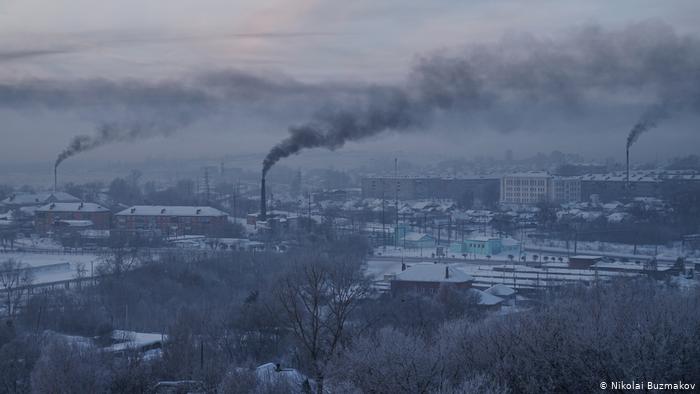
Authorities in Kuzbass say it's clean air
What happens in Kuzbass systematically happens everywhere in Russia in the business field. For profit, the enterprise owners and managers step on the rights and interests of the people. They are indifferent to how people breathe, what water they drink, what gets into the ground. The main thing is the immediate profit.
Speaking about coal in general, we can see that damage to nature is caused not only by its burning in usage. Coal mining, especially open pit mining, causes uncontrolled emissions of methane, and it affects the ozone layer of our entire planet. After coal mining, lifeless dumps of rock remain, which ignite spontaneously over the years and poison the atmosphere with combustion products for many kilometers around. There are still no examples of implementing effective reclamation technologies in Kuzbass. But it can be noted that contemporary technology is an expensive process. Therefore, today, coal mining enterprises only create the appearance of land reclamation, which is often accompanied by the planting non-native species on the territory after mining. These plants are alien, becoming an additional issue of invasion into the ecosystem that has developed here.
Black snow is very common in Kuzbass. This is coal dust
Kemerovo Region is the first in the Russian Federation in the figures of industrial production and consumption waste. In 2018, 3.6 billion tons of waste was generated on its territory, which is almost a half of the 7.3 billion tons generated throughout the country. In 2019, 3.77 billion tons of waste were generated by coal mines. This is about 60% of the total volume of waste generated on the Russian Federation territory per year.
Saving on environmental protection measures allows to make Russian coal cheap. It is beneficial for customers. But do they realize that buying cheap coal causes an irreparable harm to the nature of the entire planet? Do the customers of Russian coal in general, and Kuzbass coal in particular, understand that the price of their cheap coal is the violation of the locals’ rights to a safe environment? The worst thing is that the consequences of today's cheap coal do not go unnoticed for future descendants. The classified report of the Siberian Branch of the Russian Academy of Sciences says that Kuzbass is the leader in congenital fetal malformations (CMD). Meaning, a child has not yet been born, but his fate and his health are already predetermined by people made rich by the coal mining industry. And all that happens because a small group of coal oligarchs and bureaucrats who indulge them want to become wealthier. There is also, one can argue, an additional violation of [women’s] rights: to bear healthy offspring. Yes, such a right is not spelled out in the UN Convention on human rights, but the right for a happy motherhood is more important and should not necessarily be included in the list of human rights and freedoms. Congenital pathology of fetal development in Kuzbass occurs in average 6 times more often than in other Russian Federation regions.
Children are born with congenital malformations and are often disabled for life. In Kuzbass, infant mortality is higher than the average one in Russia.
Environmental pollution bears the danger of an increase in the frequency of congenital malformations, both because of external environmental factors influence on the developing embryo and the fetus and because of damaging the genetic structures of the parents' cells. The main danger of environmental pollution is that the arisen mutations persist for a long time and are then transmitted from generation to generation.
*Data taken from the Report of the Rospotrebnadzor of the Kemerovo Region.
You just need to think about the dramatic situation in the Kemerovo region: in addition to the violated hope for a healthy offspring, one of the fundamental human rights - the right to life - is also violated. The child has not yet been born, he is welcome in the family, he is expected and beloved, but his life and health are threatened by toxic environmental conditions, in which the mother is forced to live and carry the pregnancy.
In the Kemerovo Oblast, almost all indicators of the causes of death are higher than the average in Russia.
Mortality rate in Kemerovo oblast – Kuzbass, Russia, according to the most frequent causes of death in 2019 (standard index per 100 thousand people)
|
Causes of death |
Kemerovo oblast - Kuzbass |
Russia |
|
Infectious and parasitic diseases |
70,3 |
20,6 |
|
Neoplasms |
189,7 |
158,1 |
|
Diseases of the circulatory system |
495,9 |
416,6 |
|
Respiratory diseases |
49,2 |
31,1 |
|
Diseases of the digestive system |
66,8 |
54,4 |
|
External causes of death, including |
117,4 |
85,1 |
|
All transport accidents |
11,3 |
11,7 |
|
Assassinations |
8,4 |
4,7 |
|
Suicides |
21,1 |
10,8 |
|
Alcohol poisoning |
13,4 |
6,1 |
Recently, the Office of the Federal Penitentiary Service (UFSIN) came up with a proposal to send prisoners to building work. The first prisoners will go to the Baikal-Amur Mainline (BAM) building in June 2021. The citizens of Russia still remember GULAG and what was happening in these death camps at the ‘construction sites of the century’. Today economists’ opinion is that such a proposal has economic implications. Businesses are experiencing difficulties in exporting products to China, including coal business. The reason is the low throughput of BAM. The Russian authorities have not found any other way to solve business problems other than using prisoners’ labor. At the same time, everyone understands that there will be no control over the working conditions at such construction sites. No one so far is able to track how / if this work will be compensated. Will prisoners be tortured if they refuse to work? There is a big chance that it will be forced labor.
Can citizens of Russia influence business owners to comply with environmental legislation? No, they cannot. The entire administrative resource and the courts of the Russian Federation have long neglected the citizens` rights to a safe environment. The ultimate coal enterprises beneficiaries are mostly people close to the President of the Russian Federation. Some of them are under personal sanctions, but they all easily find ‘pocket wallets’ in the form of nominal owners and founders of companies. Businesses continue to pollute air, rivers, land, and groundwater. People continue to live in adverse conditions, often awfully close to hazardous businesses. Nobody is in a hurry to resettle them from the destroyed territory. Nobody is going to compensate them for the harm to their health. The laws of the Russian Federation are adopted so that even children born with diseases in a zone with an unfavorable ecology sometimes cannot receive a disability status or a high-tech treatment on preferential terms.
Shor environmental activists
Among such apocalypse in Kuzbass, Shors and Teleuts, indigenous small peoples, who have lived on this territory for centuries, are trying to survive. Today they suffer the most from barbaric coal mining. There are just 12 thousand of Shors left, according to the last census, and there are about 2.5 thousand Teleuts. Places of the indigenous peoples traditional residence in the Kemerovo Oblast are mainly rural areas (villages), in which culture, language, places of worship, traditional worldview (ancestor cult, fishing cult, other beliefs), as well as traditional activities (hunting, fishing, gathering, beekeeping, gardening, iron smelting until the 19th century) continue to be the main source of income and food. The village is a place of power for indigenous peoples: even if they live in a city or move for some economic or social reason, they do not lose touch with the native village. The Shors are convinced that coal mining in their area is purposefully destroying the Shor villages.
One of the most famous cases was the destruction of the Shor village Kazas by a coal mine.
Burnt house in the Shor village of Kazas
Kazas belongs to the Myskovsky Urban District and is included in the list of territories of traditional residence and traditional economic activity of the indigenous peoples of the North, Siberia and the Far East of the Russian Federation. In 2012, a construction and commissioning of a new coal mine ‘Beregovoy’ (company ‘Yuzhnaya’) began on the village territory. The license issued by the Federal Agency for Subsoil Use for the development of the ‘Beregovoy’ open pit mine required the relocation of residents of 28 houses in the Kazas village. Without consulting and informing the residents of the village, the mayor of Myski signed an agreement on resettlement with ‘Yuzhnaya’, after which the coal company began to force residents to sell houses and land plots, offering them prices 10 times less than the real value. In fact, there was no resettlement program; it was an ordinary purchase and sale of houses and plots. If the sale was refused, the coal company employees threatened to burn down the houses and destroy them with bulldozers.
‘People were forced to sell their land. We have created a difficult ecological situation, a path through the checkpoint to their houses. It is difficult to be in such an environment. Naturally, in these conditions, many residents simply sold their houses.’ (Vladislav Tannagashev, Shor)
Vladislav Tanagashev with his family
These threats have become true: in the period from November 2013 to March 2014, the houses of those who did not agree to sell were burned by unknown people. Criminal arson cases were opened, but the perpetrators were not found, although it was only possible to enter the territory through a guarded checkpoint with video cameras, which, undoubtedly, recorded the passage of the arsonists. The Prosecutor Office of the Kemerovo Oblast, in official replies to letters from Kazas residents, reported that public discussion of the residents’ resettlement by agreement with the coal company was conducted with violations, and the decision to abolish the village was not made in a legitimate way. ‘Yuzhnaya’ continued to mine coal under the obtained license without fulfilling the resettlement obligations. Members of the Council of People's Deputies of the Myskovsky Urban District discussed the issue of transferring the Kazas village to a more convenient place, but the site proposed for resettlement (Turaly District) is unsuitable for life: it is a swampy, flooded area. The situation around Kazas has been the subject of human rights reports to the UN Committees and Special Procedures. Despite the recommendations of the UN Committee on the Elimination of Racial Discrimination to restore the rights of Kazas residents, the problem has not been resolved yet: the resettlement program was never adopted, the authorities of the Russian Federation did not compensate the Shor people for the loss of land and houses, even by providing lands. In early 2020, after regular recommendations of the UN Committee on the Elimination of Racial Discrimination about the Kazas village, local authorities and representatives of the ‘Yuzhnaya’ coal company met with residents of the village but did not come to an agreement.
Kiselevsk: a house next to a coal mining
enterprise
The 2007 UN Declaration on the Rights of Indigenous Peoples, along with the recognition of other rights, contains the right of indigenous peoples to free, prior, and informed consent (FPIC), which is a prerequisite for any activity on their ancestral lands. Unfortunately, the FPIC principle is practically not implemented in the Kemerovo region. Neither the authorities, nor business owners consider it necessary to inform and to obtain a preliminary consent from the indigenous peoples to the implementation of their projects. Working with indigenous minorities and, in general, with all residents and taking their opinion into account in projects prior to their implementation is a civilized approach that avoids unnecessary conflicts and entails true development at the indigenous peoples’ territories from within.
Representatives of the authorities and business oppose independent research that would help to identify the degree of harm to the health of residents of territories with an unfavorable environmental situation. Journalists who persistently try to get the truth about the environment state, who talk about how business often neglects environmental legislation are repressed and pressured by law enforcement agencies and courts, to which business owners turn to protect their honor and dignity.
Supervisory authorities carry out formal inspections, according to the results of which they do not find any violations.
Kiselevsk: people live next to a coal mining enterprise
Residents of Kuzbass have no choice where to work, since alternative production facilities have been systematically being destroyed since 2000. The propaganda suggests that coal is the only economically viable solution for the region and nothing else is being produced in the region. Hiding objective information about the environment’s state causes people to think that living near coal mines is safe for health. Supervisory authorities are inactive. Fair courts are absent. Violations of the human right to a safe environment in the Russian Federation are simply appalling in scale. Everything is done to enrich a small group of people close to the country's government elite, to the detriment of the Russian population. However, this situation is typical not only for the coal industry. Almost all businesses in Russia, from the manufacturing representatives to waste disposal enterprises, put their interests above human rights. They will not do otherwise, as it is more profitable for business to violate human rights than to comply with ecological and environmental legislation.
In conclusion, we can single out violations of practically all human rights enshrined in the ‘UN Resolution on Human Rights’.
- Without a favorable environment, the full implementation of the human right to life is impossible. Air of poor quality and polluted water, because of which unsatisfactory sanitary life conditions arise, entail illness and even death. That is a violation of the fundamental right - the right to life.
- Representatives of local authorities and supervisory authorities often act as advocates for businesses that harm the environment. An administrative resource is being launched to pressure members of the public and the media who disagree with the current situation. Information about the environment state is hidden from the public. The ongoing research is criticized by the scientists. That is a violation of the right to receive information about the environment state, as well as the media right to be independent, providing the public with reliable information. That leads to censorship on the part of businesses and government, designed to hide the objective information.
- Disregard for international laws protecting the interests of the population while organizing industrial production leads to ecocide. Indigenous people do not have a real voice in the issue of consent to locate production near their houses. Lands of traditional use are confiscated from ethnic representatives of small peoples with the wording ‘state necessity’. This leads to the forced displacement of ethnic representatives to other territories with losing the opportunity to lead a traditional way of life, which can be regarded as ethnocide.
- Courts in Russia almost always take the side of business if social activists sue enterprises that violate the human right to a safe environment. Courts in Russia today are the least effective way to protect human rights, which is a violation of the human right to a fair trial.
- In the interests of business, the state often seizes the property of citizens, including housing and land. Compensation is almost always purely symbolic. Those with houses located near a production site are depreciated, since no one wants to buy housing in a zone with poor ecology. This is an obstacle to volatile resettlement from such territories, which entails discrimination based on the residence principle.
- In a state where human rights are neglected in the interest of business, laws are often depriving people from the opportunity to prove harm to their health due to poor ecology, as well as to get a disability status. This makes it impossible to get health care benefits and entails the inability to receive compensation for health harm. Residents of areas adjacent to industrial enterprises, for the most part, are extremely poor, therefore they do not have the access to the high-tech treatment at their own expense. And this is, again, a violation of the human right to life.
What should be done
- For thousands of years, the world has not changed. Until now, in all countries, business representatives are tempted to neglect the interests and rights of locals for the sake of profit. In some countries, those are isolated cases, in some (for example, in Russia) it is practically the policy of the authorities. We believe that it is necessary to create and publish in the public domain a ‘Black List’ of enterprises, companies, and associations related to harming the environment and committing environmental offenses. This should be an international list, which will include enterprises from all countries, as well as local officials and government officials covering environmental offenses and related to the persecution of environmental activists and journalists covering environmental issues.
- To create an international commission on environmental audit, including in it public representatives from at least 12 countries. Exclude companies, organizations, and individuals from the international ‘Black List’ of human rights violators only after examining the company, enterprise, or personal situation, if there are signs of good faith elimination of harm to the environment and after the rights of the affected territory are restored and moral and other harm is compensated.
- If companies and organizations of other countries ignore the recommendations to stop interactions with companies and enterprises involved in the violation of the human right to a safe environment, these countries' governments should accept environmental refugees from the territory where the violator operates. This should
be done with the responsibility assignment to the upkeep of refugee families with the division of responsibility in half with an enterprise or organization that continues to cooperate with violators.
- To require the state to guarantee that the principle of free, prior, and informed consent is respected in all decisions affecting indigenous peoples.
- To require the state to ratify the ILO Convention No. 169 ‘On Indigenous and Tribal Peoples in Independent Countries’ and to officially confirm its commitment to the United Nations Declaration on the Rights of Indigenous Peoples.
- It is a noble desire to save the planet for future generations. It is necessary to recognize the persecution and crimes committed against environmental activists, social activists and journalists at the international level - especially hard crimes against humanity, and subject them to consideration at the International Tribunal in The Hague.
- With more and more countries resisting UN climate change policies, environmental offenses will not decrease without tough action against countries that continue to violate human rights due to poor environmental conditions. The number of environmental disasters will increase, leading to the emergence of environmental refugees. It is necessary to recognize the existence of this problem at the international level and to introduce the concept of ‘environmental refugees’, ensuring the rights of environmental refugees on an equal basis with the rights of forced refugees.
- Human rights organizations are to recognize the persecutions of environmental activists, representatives of NGOs, and journalists dealing with the topic of ecology as ones for political reasons and to assign the persecution victims the eco-political refugee/prisoner status, admitting they were persecuted fo reco-political reasons.
- If you are ready to sign this appeal to the United Nations Organization, please contact us Адрес электронной почты защищен от спам-ботов. Для просмотра адреса в вашем браузере должен быть включен Javascript..
*https://youtu.be/cA09sxX4k (from 12th minute)
*https://www.youtube.com/watch?v=2l2ZL-Xr0gY
*https://www.youtube.com/watch?v=KjT_Z8FomWE
https://cyberleninka.ru/article/n/gigienicheskoe-obosnovanie-regionalnoy-modeli-monit oringa-vrozhdennoy-patologii-v-kuzbasse/viewer
*"Without this land I will not be able to live": violation of the rights of indigenous peoples in coal mining in southern Siberia. https://adcmemorial.org/publications/bez-etoj-zemli-zhizni-mne-ne-budet-narushen ie-prav-korennyh-narodov-pri-ugledobyche-v-yuzhnoj-sibiri/
- Comply with the principle of free, prior and informed consenthttps://indigenous-russia.com/archives/8692
- Concluding observations of the Committee on the Elimination of Racial discrimination on the twenty-third and twenty-fourth periodic reports of the Russian Federation1
https://tbinternet.ohchr.org/_layouts/15/treatybodyexternal/Download.aspx?symbol no=CERD%2fC%2fRUS%2fCO%2f23-24&Lang=en
